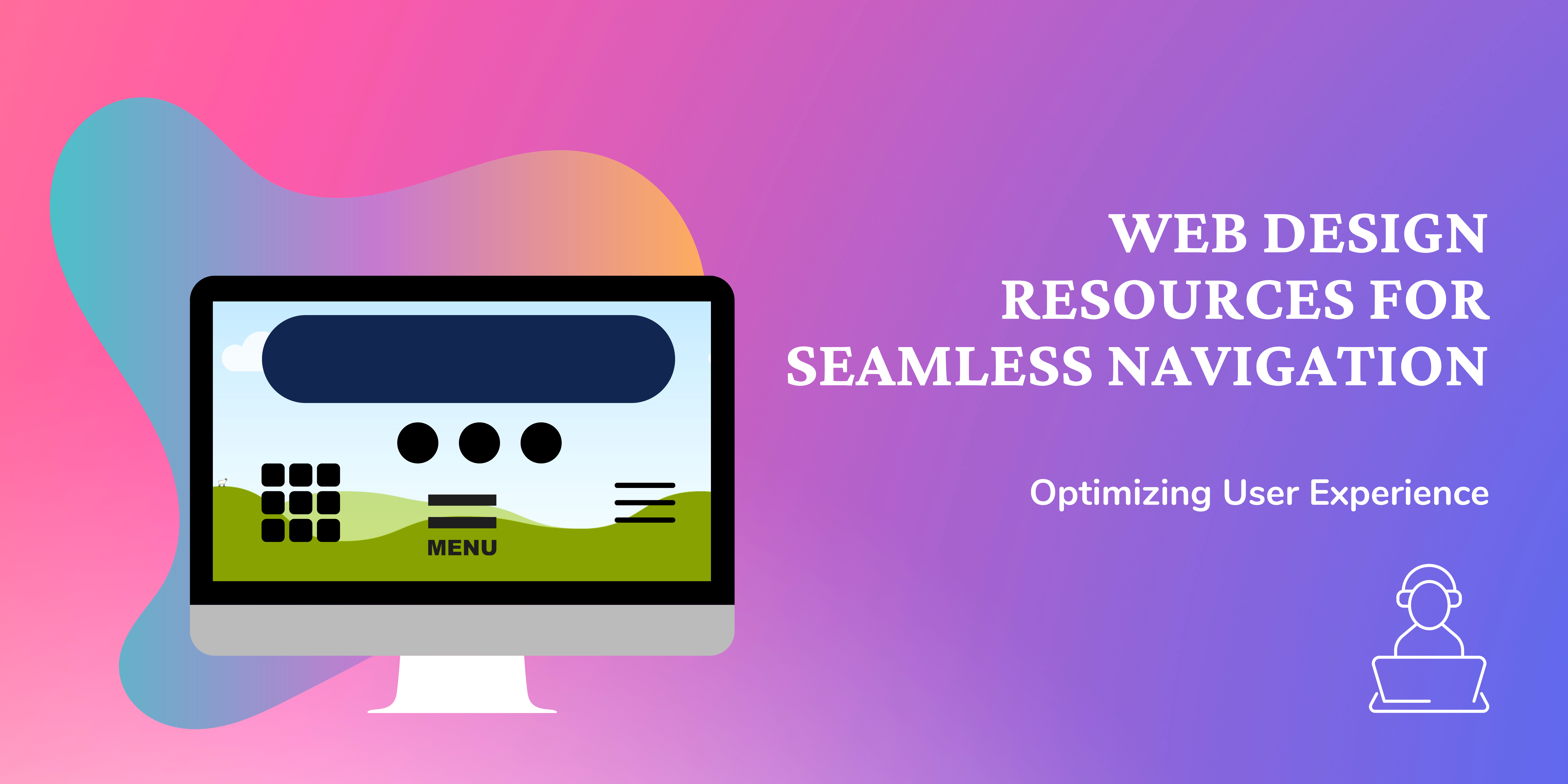Enhance your website’s user experience and navigation with these top web design resources. Discover tools and techniques to create user-friendly, SEO-optimized websites that keep visitors engaged and satisfied.
In the ever-evolving digital landscape, user experience (UX) has emerged as a critical factor for the success of websites and a good web design resources aspect. A seamless and intuitive navigation experience can make or break a user’s interaction with your website. If users find it challenging to navigate your site, they are more likely to bounce away, leading to lost opportunities and revenue.
To ensure your website stands out in the crowded online space, you need to prioritize UX design. In this article, we will explore the essential web design resources and techniques that can help you optimize user experience and create a seamless navigation journey for your visitors.
The Importance of User Experience
Before diving into the web design resources, let’s understand why user experience is so crucial for your website’s success.
1. Improved Engagement
User-friendly websites are more likely to engage visitors and keep them exploring your content. When users can easily find what they are looking for, they are more likely to spend more time on your site, decreasing bounce rates.
2. Better Conversions
A seamless navigation experience can lead to higher conversion rates. Whether your goal is to sell products, generate leads, or promote a specific action, a well-designed website can guide users toward those goals efficiently.
3. Enhanced SEO Performance
Search engines like Google consider user experience as a ranking factor. Websites that offer a better user experience tend to rank higher in search results, attracting more organic traffic.
4. Increased Trust and Credibility
A well-designed website with intuitive navigation conveys professionalism and trustworthiness. Users are more likely to trust and engage with a site that looks and feels reliable.
5. Mobile-Friendly Design
With the increasing use of mobile devices, it’s essential to have a responsive and mobile-friendly design. Websites that adapt to different screen sizes provide a consistent and enjoyable experience for all users.
Now that we understand the significance of user experience, let’s explore the web design resources that can help you optimize it.
Essential Web Design Resources for Seamless Navigation
1. Responsive Web Design Frameworks
Creating a responsive design is the foundation of a seamless user experience. Responsive web design ensures that your website adapts to various screen sizes, including desktops, tablets, and mobile devices. Here are some popular frameworks to help you achieve this:
Bootstrap: Bootstrap is one of the most widely used responsive web design frameworks. It offers a range of pre-designed components and a responsive grid system, making it easy to create mobile-friendly websites.
Foundation: Foundation is another excellent choice for responsive design. It provides a flexible grid system and a variety of UI components for building responsive websites from scratch.
Semantic UI: Semantic UI focuses on making the code more human-readable, which can help with collaboration among designers and developers. It also offers responsive design elements.
2. Content Management Systems (CMS)
A good CMS can streamline the process of creating and managing content on your website, making it easier to maintain a user-friendly experience. Popular CMS options include:
WordPress: WordPress is a user-friendly CMS with a vast library of themes and plugins. Its intuitive interface makes it accessible to beginners, and its SEO-friendly features are well-documented.
Drupal: Drupal is a robust CMS known for its flexibility and scalability. It’s an excellent choice for complex websites with advanced user roles and permissions.
Joomla: Joomla strikes a balance between ease of use and advanced features. It’s suitable for small to medium-sized websites and offers various extensions for enhancing functionality.
3. User Interface (UI) Design Tools
Creating an intuitive user interface is essential for navigation. UI design tools can help you craft visually appealing and user-friendly interfaces. Some popular options include:
Sketch: Sketch is a vector-based design tool that is popular among UX/UI designers. It’s known for its simplicity and ease of use, making it a great choice for creating website prototypes.
Adobe XD: Adobe XD is another powerful tool for designing user interfaces and interactive prototypes. It offers collaborative features, making it suitable for team projects.
Figma: Figma is a web-based design tool that allows real-time collaboration. It’s highly versatile and offers features for both UI and UX design.
4. Website Performance Optimization Tools
Website speed is a critical factor in user experience. Slow-loading websites frustrate users and can lead to high bounce rates. Use these tools to optimize your website’s performance:
Google PageSpeed Insights: This tool analyzes your website’s performance and provides suggestions for improvement. It also gives you a mobile and desktop score, helping you identify areas that need attention.
GTmetrix: GTmetrix provides detailed insights into your website’s speed and offers recommendations for optimization. It also lets you compare your site’s performance against competitors.
Pingdom: Pingdom offers website monitoring and performance testing. It provides a waterfall chart that shows the loading times of individual page elements, helping you pinpoint bottlenecks.
5. User Experience Testing Tools
Testing is crucial to ensuring that your website is genuinely user-friendly. These tools can help you gather valuable feedback and insights from real users:
UsabilityHub: UsabilityHub offers a suite of tools for testing different aspects of your website’s usability, including navigation, design, and content. It provides quick and actionable feedback.
Optimal Workshop: Optimal Workshop specializes in information architecture and navigation testing. It helps you understand how users interact with your site’s menu structure and content hierarchy.
Hotjar: Hotjar offers heatmaps, session recordings, and surveys to help you visualize user behavior on your website. It’s a valuable tool for identifying pain points in the user journey.
6. Accessibility Testing Tools
Ensuring that your website is accessible to all users, including those with disabilities, is an essential aspect of user experience. These tools can help you test and improve accessibility:
Color Contrast Checker: Ensuring proper color contrast is vital for users with visual impairments. There are various online tools available to check color contrast compliance, such as the one provided by WebAIM.
Web Design Techniques for Seamless Navigation
In addition to using the right web design resources, implementing best practices in web design is crucial for optimizing user experience. Here are some techniques to consider:
1. Clear Navigation Menu
A clear and well-organized navigation menu is the backbone of a user-friendly website. Ensure that your menu is prominently placed, typically at the top or side of your webpage, and uses descriptive labels for menu items. Users should easily understand the purpose of each menu item without confusion. Consider implementing a sticky menu that remains visible as users scroll down the page, allowing easy access to navigation options at all times.
2. Intuitive Information Architecture
Information architecture refers to how your content is organized and presented to users. Organize your content in a logical and intuitive manner, utilizing categories, subcategories, and tags. A clear hierarchy helps users find what they’re looking for without unnecessary clicks or confusion. Consider conducting user testing or surveys to ensure that your site’s information architecture aligns with user expectations and needs.
3. Consistent Design Elements
Consistency in design elements across your website is crucial for creating a cohesive user experience. Ensure that fonts, colors, buttons, and other design elements remain consistent throughout all pages. When users encounter a familiar design pattern, they feel more at ease and can navigate your site with confidence. Consistency also helps in reinforcing your brand identity.
4. Mobile-Friendly Design
In today’s mobile-dominated world, it’s imperative to ensure that your website is responsive and mobile-friendly. Test your website on various devices and screen sizes to guarantee that it provides an optimal user experience for mobile users. Responsive design ensures that your content adapts seamlessly to different screen sizes, eliminating the need for horizontal scrolling or zooming.
5. Page Load Speed
Website speed is a critical factor in user experience. Users have little patience for slow-loading pages, which can result in frustration and high bounce rates. Optimize your website’s load times by compressing images, minifying CSS and JavaScript files, and utilizing browser caching. Fast-loading pages not only enhance user satisfaction but also contribute to improved search engine rankings.
6. Call-to-Action (CTA) Placement
Strategically place clear and compelling CTAs throughout your website. CTAs prompt users to take specific actions, such as signing up for a newsletter, making a purchase, or contacting your business. Ensure that these CTAs are well-designed, easy to spot, and guide users toward your desired goals. Their placement should align with the user’s journey and the content they are engaging with.
7. Whitespace and Clutter-Free Design
Whitespace, also known as negative space, is the empty space around content and design elements. Incorporating whitespace generously into your web design helps prevent your website from appearing cluttered and overwhelming. Well-spaced content and elements make it easier for users to focus on what’s important and navigate through your content without feeling overwhelmed.
8. User-Friendly Forms
If your website includes forms for purposes such as contact, registration, or feedback, it’s essential to make them user-friendly. Keep forms concise, asking for only the necessary information. Provide clear instructions and validation messages to guide users through the form completion process. Ensure that the form fields are easy to understand and complete, even for users with limited technical expertise.
9. Feedback Mechanisms
Including feedback mechanisms on your website, such as contact forms, live chat, or chatbots, enables users to easily reach out with questions, concerns, or feedback. Responsive customer support enhances trust and engagement. Ensure that these feedback channels are accessible and responsive, providing users with timely assistance when needed.
10. Cross-Browser Compatibility
Not all users access your website using the same web browser. Therefore, it’s crucial to test your website on different browsers to ensure that it functions correctly and looks consistent across all of them. Cross-browser compatibility ensures that users have a consistent and smooth experience regardless of their preferred browser, reducing the risk of usability issues or visual discrepancies.
Incorporating these ten web design techniques into your website development process will significantly enhance user experience and streamline navigation, ultimately leading to increased user engagement and satisfaction. Keep in mind that user-centric design is an ongoing process, and regularly gathering user feedback and analyzing website analytics can help you continuously refine and optimize your website’s navigation and overall user experience.
Conclusion
In conclusion, implementing effective Tech Deals for seamless navigation is paramount in creating a positive and engaging user experience. By adhering to these principles, you not only enhance user satisfaction but also improve the overall performance and success of your website. Clear navigation menus, intuitive information architecture, consistent design elements, and mobile-friendliness ensure that users can easily find and interact with your content.


